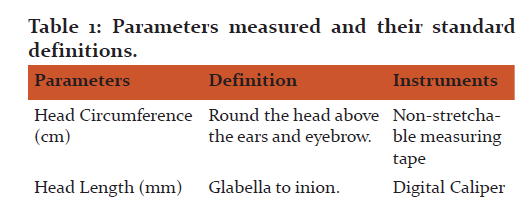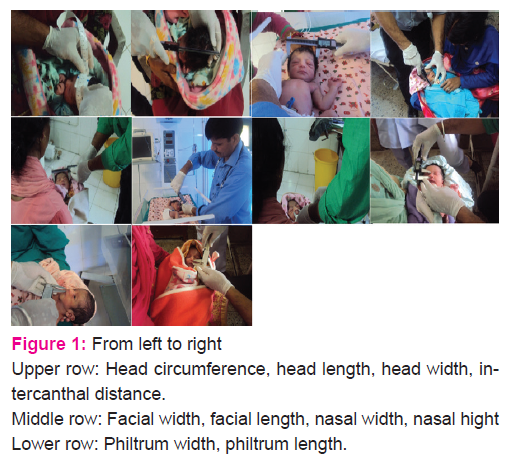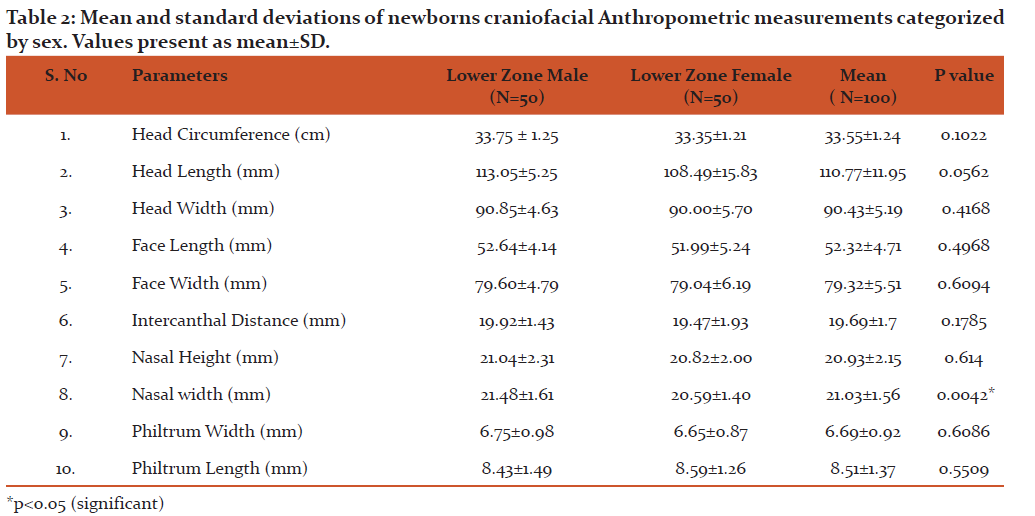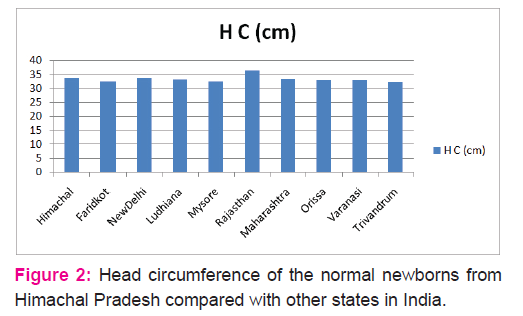IJCRR - 9(7), April, 2017
Pages: 23-27
Date of Publication: 11-Apr-2017
Print Article
Download XML Download PDF
Craniofacial Anthropometric Measurement of Normal Full Term Newborns in Lower Hills of Himachal Pradesh
Author: Soni Pankaj, K. Prabhakaran, Kapoor Kanchan
Category: Healthcare
Abstract:Introduction: Anthropometric measurements of infant body help us to predict their health and future growth. The objective of this study is to document anthropometric data of normal newborns in Himachal Pradesh. This work will definitely prove a contribution in the anthropometric study as hardly any research work is done on this subject in Himachal Pradesh.
Methods: 100 normal full term newborns comprising 50 males 50 females delivered in labor ward of civil hospitals in Himachal Pradesh, measured within12-24 hours after birth. The mean and SD values for different cranio-facial dimensions were obtained by using Digital caliper and non-stretchable measuring tape.
Result: All the parameters were significantly (p< 0.001) correlated to each other. With regards to head width, facial width showed the highest correlation (r=0.756) in females, (r=0.686) in males as compared to other anthropometric parameters. Facial width is the best surrogate to predict head width. Parson's correlation coefficient for head circumference showed high significant with head length (r=0.617), head width (r=0.617), facial width (r=0.673) in males. The mean value and standard deviation (Mean\?SD) for different craniofacial anthropometric parameters were obtained and high significant was found in nasal height for male and female (p=0.0042).
Keywords: Anthropometric, New born, Himachal, Cranio-facial, Correlation, Full term
Full Text:
INTRODUCTION
All health personnel having responsibility for the care of children should be sufficiently familiar with normal patterns of growth and milestones so that they can recognize overt deviations from the normal range as early as possible, in order for underlying disorders to be identified and given appropriate attention (Alshemeri et al, 2008). The evaluation and measurement of human body dimensions is achieved by physical anthropometry. The human body dimensions are affected by ecological, biological, geographical, racial, gender and age factors (Golalipour et al, 2003).
Man has an unending, and perpetual quest to acquire more and more knowledge about him and the nature around him. He endeavour’s to unfold, unravel various areas of human importance and always tries to extend the boundaries of his wisdom and knowledge. The geographical location, racial and environmental factors are responsible for the growth and body composition. As the geographical and environmental conditions of Himachal Pradesh are different from rest of the India In view of this we selected to undertake an anthropometric study of normal newborns in hills of Himachal Pradesh, which is known for its unique and uncanny socio-political and cultural traditions. Its unique composition, location, and character all makes it the bounder land. (Balokhara et al, 2014).
The birth size is the result of fetal growth. The fetal growth which commences shortly after conception is largely determined genetically with the modification of this genetic process by the environment. In several studies, researchers have been used anthropometric measurements, such as weight length in order to evaluate growth of infants; some also used the head circumference. (Alshemeri et al, 2008).
AIM AND OBJECTIVE
Present study was performed with objective to find correlation between craniofacial anthropometric measurements of full term newborns and to conduct normograms for all the anthropometric measurements studied. This provide base line data for indigenous population and can be gainfully employed for further studies to know whether anthropometric measurements other than birth weight will be useful to quantitate fetal growth and to identify at risk babies in rural community level. This study was also planned to contribute to the collection of newborn standard craniofacial parameters of Himachali.
MATERIALS AND METHODS:
The study was undertaken on 100 normal full term newborns comprising 50 males and 50 females of lower hills of Himachal Pradesh (Elevation 350-1500 meters from sea level) from the district of Kangra, Una, Hamirpur, Bilaspur, Mandi in the labor ward of civil hospitals as dimension of newborn’s can be basis for all changes in anthropometric indices which will be helpful for anatomists, forensic scientists, plastic surgeons, general surgeon, pediatrics, medical imaging and Physical anthropologists.
All the newborns were evaluated in 12- 24 hours after birth. Ethical clearance is taken from Geetanjali University, Udaipur, Rajasthan, (India). Informed consent of mother /father /guardians was taken before measurements.
The anthropometric dimensions do not take into consideration the study of the Neonates of high risk or complicated pregnancies having medical illness such as hypertension, diabetes mellitus, infection, autoimmune disease, heart disease etc., neonate who had caput succedaneum and cephalheamatoma and Neonates delivered by caesarean section showing any craniofacial deformity.
Parameters measured and their standard definitions are presented in the following table:1 and Figure:1



Observation and Result:
The present study conducted to obtain a baseline standard criterion (Mean±SD) for craniofacial parameters of normal full term newborns of lower Himachal Pradesh and their inter-correlation. Independent sample t test were applied to find significant difference between different parameters among male and female. There is no significant difference in anthropometric measurements of male and female except nasal width which is highly significant (p=0.0042). (Table-2)
All the parameters were significantly (p<0.001) correlated to each other. With regards to head width, facial width showed the highest correlation (r=0.756) in females, (r=0.686) in males as compared to other anthropometric parameters. Pearson’s correlation coefficient for head circumference showed high significant with head length (r=0.617), head width (r=0.617), facial width (r=0.673) in males. (Table-3, 4)
The mean and SD of HC, HL, HW, FL, FW, PW and PL of male and female described in table-2. The mean value for male is higher than female.



DISCUSSION
It is universally acknowledge the size at birth is an important indicator of fetal and neonatal health in the context of the both individuals and populations. Size at birth reflects two factors: duration of gestation and rate of fetal growth. It must therefore be considered with respect to gestational age; otherwise the increase in size that occurs with age will lead to severe confounding of growth and maturity. (Kramer et al, 1990) India is a land of diversity and people of different province have different food habits, life style, socio-cultural trend and ethnicity. The diversity is evident in their physical structure and anthropometric parameters. It is essential to study the physical features and environment in which a particular community is living. In the present study, the mean values of anthropometric parameters of normal full term newborns were compared with other states in India.
The present study shows mean head circumference of the normal full term newborns for both group (male and female n=100) was 33.55±1.24 cm and individual mean values for male 33.75±1.25 cm and female 33.35±1.21 cm respectively. The mean value of head circumference (male and female, n=100) was compared with similar study conducted in other states of india shown in bar chart (fig.2). The values for present study was higher than the study conducted by Agnihotri et al, 2007 (33.25) cm, Kaur et al, 2013, (32.68±2.3) cm, Pachauri et al, 1970 (33.15) cm, Taksande et al, 2015 (33.52±1.92) cm, Anupama et al, 2013 (32.60±2.59) cm, Jaya et al, 1995 (32.36±1.63) cm, Mohanta et al, 1972 (33.12) cm. The head circumference in our study was lower than the study conducted by Kataria et al, 2014, (36.55±1.18) cm Pachauri et al, 1971, (33.74±2.21) cm.
Pearson’s correlation coefficient for head circumference showed high significant with head length (r=0.617), head width (r=0.617), facial width (r=0.673) intercanthal distance (r=0.483) in males. (Table-3, 4)

Present study shows the mean nasal height of normal full term newborns (male and female n=100) was (20.93±2.15) mm, and individual mean values for male and female was 21.04±2.31 mm, 20.82±2.00 mm with p=0.614 respectively. The mean value for both group as well individual group compared with similar study conducted by Ghosh et al, 2013 shown in (Table-5). The mean nasal width 21.48±1.61 mm for male and 20.59±1.40 mm for female which is highly significant (p=0.0042)
The philtrum of the upper lip has a unique configuration and is a landmark of individual distinction. (Agnihotri et al, 2007). The mean philtrum width for both group n=100 in present study was 6.69±0.92 mm and individual group male 6.75±0.98 mm, female 6.65±0.87 mm respectively. The mean value for both the group was compared with similar study conducted by Ghosh et al, 2013 and Agnihotri et al, 2007 (Table-5).

CONCLUSION
The value of physical growth data indicates the important role of geographic location as an environmental factor on fetal growth. Various studies have shown that male babies are larger than female babies. (Taksande et al, 2015). Similar findings were present in our study group. Always attention should be given to ethnic, social, economic and geographical variations when comparing physical parameters. In the Present study Facial width is the best substitute to predict head width.
ACKNOWLEDGEMENT
The author acknowledge and thank the guidance provided by Professor Dr. Suresh Soni, Postgraduate College, Bilaspur, H.P. and sincere thanks to Directorate of health Services, Shimla, Himachal Pradesh for their support.
Funding: No funding sources
Conflict of Interest: None Declared
References:
1. Agnihotri G and Singh D. Craniofacial Anthropometry in Newborns and Infants. Iran J Pediatr. 2007; 17 (4): 332-38.
2. Anupama MP and Dakshayani KR. The Study of Anthropometric Measurements of Newborn Babies in Relation to Maternal Illness. Anatomica Karnataka. 2013; 7(1): 67-71.
3. Anupama M P and Dakshayani K R. The Study of Anthropometricn Measurements of Newborn Babies in Relation to Ges-tational Age. International Journal of Recent Trends in Science and Technology. 2014; 10(1):133-35.
4. Balokhara JM. The Wonderland Himachal Pradesh. 1st ed. India. H.G publication. 2011.
5. Ghosh A, Manjari C and Mahapatra S. The craniofacial anthropometric measurement in a population of normal newborns of Kolkata. Nepal Journal of Medical sciences. 2013; 2(2):125-29.
6. Golalipour MJ, Haidari K, Jahanshahi M and Farahani R.M. The Shapes of Head and Face in Normal Male Newborns In South- East of Caspian Sea (Iran-Gorgan). J Anat. Soc. India. 2003; 52(1): 28-31.
7. Jaya DS, Kumar NS and Bai LS. Anthropometric indices, cord length and placental weight in newborns. Nutrition research centre directorate of health services, thiruvananthapuram. 1995;
32:1183-88.
8. Kataria SK and Gaur S. An Anthropometric Study of Normal Full Term Newborns at Birth in Western Rajasthan. International Journal of Advanced Research. 2014; 2(10): 671-75.
9. Kaur M, Singh Z, Kaur G and Goyal LD. Correlation of birth weight with other anthropometric measurements of newborns. Indian Journal of Basic and Applied Medical Research. 2013;
8(2): 870-79.
10. Mohanta KD, Panda TN and Praharaj KC. Anthropometric measurements of children of Western Orissa. Indian J. Pediat. 1972; 39(1):12-14.
11. Pachauri S and Marwah SM. An anthropometric study of the newborn in Varanasi. The Indian Journal of Pediatrics. 1970; 37(2):47-53.
12. Pachauri S and Marwah SM. An anthropometric study of the newborn in a New Delhi urban community. The Indian Journal of Pediatrics. 1971; 38(7): 291-97.
13. Jreal M. Tourism in Himachal Pradesh. Indus Publication. New Delhi. 2004
14. Taksande AM, Lakhkar B and Gadekar A. Anthropometric measurements of term neonates in tertiary care hospital of Wardha district. Al Ameen J Med Sci. 2015; 8(2):140-43.
|






 This work is licensed under a Creative Commons Attribution-NonCommercial 4.0 International License
This work is licensed under a Creative Commons Attribution-NonCommercial 4.0 International License